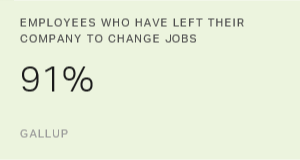Story Highlights
- First, companies need to study their best performers
- A strong employee value proposition attracts talent
- An effective EVP sets a company apart
When leaders see their best performers achieve business outcomes, they no doubt wish they could get more similarly talented people to apply to and join their company.
Fortunately, any business can attract applicants who are more likely to be top performers and a good cultural fit by using some simple strategies for developing a focused employee value proposition (EVP). In this context, an EVP -- which is closely related to the concept of a company's employment brand -- articulates the balance of the rewards and benefits that employees collect in return for what they contribute to a workplace.
Here's an example of an effective EVP in action: When Apple added full education reimbursement for workers to its list of employee perks, some onlookers might have said, "What an extraordinary investment in their employees" or "What a great way to develop their workforce and to retain talented employees." But in Silicon Valley, those directly involved in the hunt for top talent realized that in the same way that Apple creates innovative new products, it had created an attraction strategy that differentiated the company from its competitors -- and that appealed directly to the type of employee it wanted to hire. Apple's brilliantly defined employment brand not only speaks to people with a strong desire to learn and grow, but also says a lot about the company's culture and what it values.
In a nutshell, Apple's EVP appeals to the right kind of people -- those who want to learn and grow and who are likely to be engaged with Apple's development-oriented culture.
As Apple undoubtedly knows, talented workers are well worth the effort it takes to recruit and hire them. Gallup meta-analysis results suggest that when companies select the top 20% most talented candidates for a role, they frequently realize a 10% increase in productivity, a 20% increase in sales, a 30% increase in profitability, a 10% decrease in turnover and a 25% decrease in unscheduled absences.
After bringing talented people in, an organization can further serve its bottom line by engaging employees at all levels. Gallup has found that the most highly engaged business units are 21% more productive, experience 48% fewer safety incidents, are 22% more profitable, have 10% better customer ratings and experience 37% less absenteeism.
Best Practices From Companies With Strong EVPs
The right talent selection and management practices offer a powerful approach to human capital that should be central to any leader's business strategy. This approach begins with a carefully crafted EVP that attracts the applicants who are most likely to be top performers and a good cultural fit.
Companies with the very best EVPs apply the following best practices:
They understand their best performers. Companies can use an evidence-based approach to develop a definitive guide for attracting applicants with the most potential to thrive. This approach requires understanding the characteristics of top performers -- particularly, what initially attracted them to the company -- and then translating those findings into messages that entice other high performers.
Conducting interviews and focus groups with top performers can also help companies glean rich information for crafting communications that convey the specific elements of the business that appeal to its best workers. These tailored applicant attraction messages can help businesses draw in people who are similar to other high-talent workers.
They connect their applicant messages to their culture. Just because a candidate has the talent to be a top performer in a role doesn't mean he or she is a good fit for a company's organizational culture. Leaders need to ensure that their applicant attraction message accurately reflects the business' work environment. Using communications that enable potential applicants to understand what to expect from the workplace helps companies appeal to people who not only possess top talent but also are more likely to be engaged with the organization and a good fit with other workers and the company mission.
They differentiate themselves from the competition. A company's applicant attraction message should help it stand out from its competitors and provide potential hires with compelling reasons to choose the company as a workplace. To ensure companies are differentiating themselves, they need to analyze their employment brand's effectiveness and authenticity and then compare their brand with competitors' to capitalize on differentiators. When a company's EVP highlights the company's unique qualities, it can set the business apart, win the attention of desirable applicants and promote the company's brand.
Here is an example of a best practice in action at a large, successful company Gallup studied. The company discovered that candidates who were more likely to have successful careers after they were hired were the ones most excited during their interviews about future-oriented aspects of the job, such as opportunities to learn and grow and to advance in their careers. In contrast, candidates who were less likely to have successful careers were most excited about immediate and superficial job aspects, such as high compensation, good benefits and tangible perks.
The company was able to use these insights to develop a focused, targeted EVP that appeals to those most likely to be successful. Even though the company pays very well, its job ads don't mention compensation because it would attract the wrong kind of applicant.
Companies spend a lot of time and money on marketing campaigns to attract loyal customers. Unfortunately, they often neglect to develop an equally strong employment brand to attract valuable, five-star talent. Studying top performers is a necessary first step; leaders then need to craft an EVP that accurately reflects their company's culture and sets it apart from the competition.
With the right type of applicant knocking at a company's door, leaders can be more selective about whom they hire, and they can fill every position with someone who is the right fit. When leaders focus on attracting a large quantity of applicants rather than on attracting high-quality applicants, however, they miss the mark significantly.



